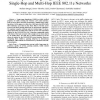Free Online Productivity Tools
i2Speak
i2Symbol
i2OCR
iTex2Img
iWeb2Print
iWeb2Shot
i2Type
iPdf2Split
iPdf2Merge
i2Bopomofo
i2Arabic
i2Style
i2Image
i2PDF
iLatex2Rtf
Sci2ools
GLOBECOM
2008
IEEE
2008
IEEE
Transport of Long-Range Dependent Traffic in Single-Hop and Multi-Hop IEEE 802.11e Networks
Long-range dependence (LRD) is a widely verified property of traffic crossing the wireless LAN radio interface. LRD severely affects network performance yielding longer queuing delays. In this paper, we study how LRD and non-LRD traffic flows influence each other in the IEEE 802.11e wireless access network and their queuing behaviour in downstream schedulers. We consider scenarios with one and two wireless hops. We investigate interaction of traffic flows with the service class separation enabled by the IEEE 802.11e EDCA function, comparing results with those of the basic scenario with a single service class shared by all traffic flows. We find that a partial isolation of service classes is enabled by the IEEE 802.11e access function. However, competing flows exhibit a queuing behavior, in downstream schedulers, which cannot be accounted for by standard LRD traffic descriptors.
| Added | 29 May 2010 |
| Updated | 29 May 2010 |
| Type | Conference |
| Year | 2008 |
| Where | GLOBECOM |
| Authors | Stefano Bregni, Paolo Giacomazzi, Gabriella Saddemi |
Comments (0)

